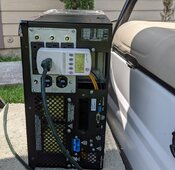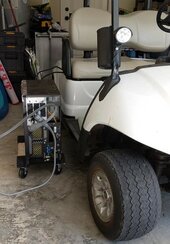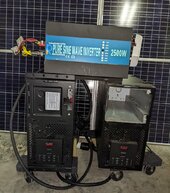Hello everyone. Newbie here.
Some background on my project:
I have an electric side by side. Intimidator EV Classic.
https://intimidatorutv.com/classic-ev/
It comes with 8, 6V Lead Acid batteries.
I am replacing those with 8, 48V Eagle batteries from Bigbattery.com
https://bigbattery.com/products/48v-eagle-lifepo4-30ah-1-53kwh/
Each of those is ~1.5KWH, so I should end up with ~12KWh of battery.
I'm doing this to extend the range and usable power of the EV (with lead acid, both are horrible)
That being said, it occurred to me that I could use my EV SXS as a battery bank for short term power outages, instead of my stinky gas generator.
On average, I use 30 KWh per day at my house in the winter. 30/24 = 1.25 per hour, so with 12 KWh of battery, I am thinking 8 hours is a probable outcome.
I figured I would buy a 6000 Watt 240 V inverter to fill this need.
If all holds true, plan is this:
Power goes out
Swap power from grid to Inverter (this is in place, except for generator)
Pull EV to Inverter
Turn off all batteries
Connect EV to Inverter
Turn on all batteries
Turn on inverter
Am I missing anything, overlooking anything, out of my mind, etc?
Any feedback is greatly appreciated.
I also just watched the latest video with the 5KW chargeverter, where it was pointed out that small power generators (mine is a 7500 constant) won't work well for charging batteries through an inverter. I was kind of hoping to hook my generator to the inverter, if outage lasted longer than 8 hours, so I could recharge and power the home. This recent info seems to indicate that won't work out so well.
Some background on my project:
I have an electric side by side. Intimidator EV Classic.
https://intimidatorutv.com/classic-ev/
It comes with 8, 6V Lead Acid batteries.
I am replacing those with 8, 48V Eagle batteries from Bigbattery.com
https://bigbattery.com/products/48v-eagle-lifepo4-30ah-1-53kwh/
Each of those is ~1.5KWH, so I should end up with ~12KWh of battery.
I'm doing this to extend the range and usable power of the EV (with lead acid, both are horrible)
That being said, it occurred to me that I could use my EV SXS as a battery bank for short term power outages, instead of my stinky gas generator.
On average, I use 30 KWh per day at my house in the winter. 30/24 = 1.25 per hour, so with 12 KWh of battery, I am thinking 8 hours is a probable outcome.
I figured I would buy a 6000 Watt 240 V inverter to fill this need.
If all holds true, plan is this:
Power goes out
Swap power from grid to Inverter (this is in place, except for generator)
Pull EV to Inverter
Turn off all batteries
Connect EV to Inverter
Turn on all batteries
Turn on inverter
Am I missing anything, overlooking anything, out of my mind, etc?
Any feedback is greatly appreciated.
I also just watched the latest video with the 5KW chargeverter, where it was pointed out that small power generators (mine is a 7500 constant) won't work well for charging batteries through an inverter. I was kind of hoping to hook my generator to the inverter, if outage lasted longer than 8 hours, so I could recharge and power the home. This recent info seems to indicate that won't work out so well.





